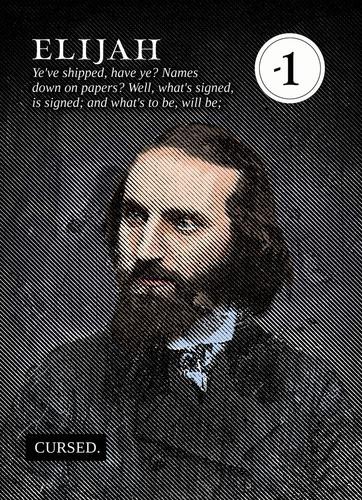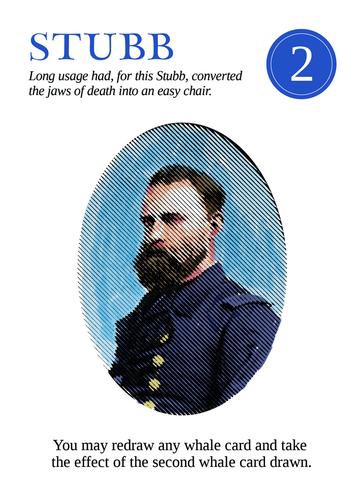"Moby Dick": The Game
by Noah Davis
They created the project with Andy Kopas, Mark Perloff, and John Kauderer. Today it went live for fundraising on Kickstarter, with a goal of $25,000. The game mechanics combine luck and skill, much like a 19th century whaling hunt. Sailors die constantly, casualties of stoved boats, whale charges, and other tragedies. The game culminates in a battle against the White Whale. It’s brutal, smart, and strangely endearing.
Obviously, I had some questions.
Originally, this was going to be a video game. Why isn’t it?
Tavit: We first started talking about adapting Moby Dick into a video game two or three years ago. I worked in the industry making TripleA games, and EA had just released “Dante’s Inferno.” We were both super passionate about Moby Dick, and we loved the idea of bringing the epicness of Melville’s work into something that you could hold and interact with.
Joel: I was really into the idea of the open world. In the video game, you would run the narrative of the book, and then you would enter this nexus of the ocean. But we realized that no one would put $20 million behind that because the crossover of the hard-core gamer to the hard-core literature enthusiast basically doesn’t exist.
The circles of “high-concept card game player” and “epic novel reader” are probably much closer to concentric.
Joel: Yeah. And a card game has a more classic feel.
Tavit: We had been having late-night jamming sessions talking about the video game. We were sitting around one day with our other partner, Andy, and he suggested a strategy card game. It was like a light bulb switched on in all of our heads. It felt right. The card game is an anti-video game. It’s incredibly literate. It’s very, very wedded to the concept of the literature that it comes from, which has been Joel’s huge undertaking. But it works. The pacing and the social aspect of playing with your friends is kind of like a book club or a reading club.
Joel: It was also more attainable. When we were talking about making a video game, Tavit said he knew the perfect guys to make the water, but it would cost like $4 million or something absurd. Now, we can get art that really pops because there is so much amazing documentation from that time period. We’re using daguerreotypes, ambrotypes, and other old photo processes. For the most part, it’s public domain. We licensed some images through agreements with universities.

Where did you get the art?
Joel: About 20 percent is coming from the New Bedford Whaling Museum. They are excited. They are going to have the game in the gift shop. That’s cool because they have the best collection.
You spent a lot of time trying to be faithful to the text and spirit of the book. Are you worried that will keep people who haven’t read it away?
Joel: Absolutely. Everything gets checked against the book at every step. We would have rule conversations and there would be an impasse where I would say, “it cannot be this way [because it wouldn’t make sense in the Moby Dick universe].” Some rules make the game so esoteric, and people who haven’t read the book will ask why.
Tavit: We worry that it won’t be applicable to people who haven’t read the book, but I’m learning that the fundamentals of the game create a space for exploring the concepts in the book. Reading it is always going to be the best way to take it in, but the game can help. This is a bit of an apples to oranges comparison, but when Guitar Hero came out as a video game, people connected with the songs that were in the video games in a very different way because it was interactive. I was listening to music out of the game that I wouldn’t have if I hadn’t jammed on it in the game. In that same way, we’re hoping that with this project, those weird esoteric rules become questions in peoples’ minds and pull them closer to the text.
I can see how those rules would set the entry barrier higher, but maybe ultimately make it more rewarding if people stuck with the game.
Joel: Melville’s whole project was to explain every little detail to people who had never been whaling. That’s what’s so hard about the book. There are huge sections of it that explain things like what the rope does in detail. And it’s really, really important that you know exactly what it does because it really matters later. Ishmael, as a character, disappears. He’s just describing the scene. Melville wants to put you in the whale boat. A game is the perfect way to put you in a whale boat and to make you feel those feelings.
Building a gaming system, especially one this complex, seems like an impossible task. How did you do it?
Tavit: It was painfully slow. We’ve been working on this for nine months. It starts out with genial, 50,000-foot conversations about what type of game it is. It’s a card game, but do we need a board? We’d throw concepts at the wall. We tried to get it to a playable prototype, and then we added and subtracted features. We’re in the third full-on version of the game now. There have been elements that have carried through all of them, but it’s really a matter of creating features, testing features, and seeing how those mechanics interact with each other. We had one really cool working version of the game but there was a moment where we realized that we weren’t communicating with the sailors. There was no feeling. Without that identity, we lost the highest part of the concept. That’s when we revised. We always knew that the goal of the game was to be the survivor, not the winner. Players don’t win this game; they simply survive it. That had to stay consistent.
Joel: No one was going to kill Moby Dick.
Tavit: No way. Moby Dick always kills you.
Joel: We all would have walked out. There was nobody pushing for that.

The gameplay is totally brutal. Characters are constantly dying, which is frustrating but I suppose pretty consistent with the reality of whaling?
Joel: There are highs and lows. That’s one thing I love about it. It really is fateful. There are times when you are riding high and nothing can stop you, but then in the blink of an eye, you’re so low. But then you’re back again. It swings violently. It really is life on the sea.
Tavit: It’s really interesting to be working on a game that is based on something that has such a strong intellectual property. Everyone knows Moby Dick, so we get immediate reactions. Either “That’s really cool!” or “That’s really boring.” If we can create the same dialectic split that Melville did with his polarizing work I think we’ve succeeded, at least in the high-concept sense.
Joel: We talked a lot about softening the bottom. The game is devastating. It had to be devastating. We all agreed that it needed to be very, very difficult, but we rounded the bottom so you always take your shot. Because why not? If you’re brought low, you’ll be back before you know it. That way, it’s fun. When you succeed, it’s triumphant, and when you fail, it’s desolate but you’re right back to succeeding again.
Tavit: One of the core concepts of the game design was that there shouldn’t be too many times when not all of the players were invested in what was happening. There might be a time where not everyone is controlling their actions, but most of the things that happen in the game affect the entire crew. It’s definitely competitive, but there’s a cooperative nature to it. In the game, we are all sailors aboard the Pequod and we all have a linked fate, which is doom. But along the ride, there are so many opportunities to help your fellow sailors.
Why did you turn to Kickstarter for funding?
Tavit: I used to work with Killscreen Magazine, and we had a lot of success launching products that way. We learned that Kickstarter was a great platform not only for promoting your products, but also for selling them. We’ve bootstrapped our last nine months — doing the design and getting the art — but we are at a crossroads where to functionally make a game at the quality that we want to is going to require a wholesale order.
Joel: I feel like there’s a renaissance of tabletop games, and it’s a crossover, too. People go on Kickstarter looking for a new game.
Don’t take this the wrong way, but are you worried this is the most Brooklyn thing ever?
Tavit: [Laughs] No. I’m from Harlem. You can quote me on that. But yeah, it feels like it belongs in a coffee shop or a bookstore. I can totally see this being a Brooklyn hipster thing, but hopefully the IP will carry it out of there. Moby Dick is timeless.
Joel: And we’re not exploiting the fiction. There are a lot of pieces of art that get created out of Moby Dick…
Tavit: Like EmojiDick.
Joel: And I think that we have endeavored to make a lasting product. Even more than a video game, a card game won’t date itself. I think there’s something exciting about that.
The challenge of creating the Ishmael character seems especially daunting.
Joel: The big failing of any film or television adaptation is that sense of your presence. They always put Ishmael on the screen. Everyone has their own vision of Ishmael. He’s almost blurred. Peter Mendelsund wrote a piece about being able to hear Ishmael’s words more than you can see his face, and I think that applies. When there’s a film and Ishmael is walking around as the main character, it feels strange. I don’t think Melville ever intended for Ishmael to be described. That’s why I’m so excited about our Ishmael card. I think it really encapsulates the omniscient narrator. All the sailor cards are portraits, except for Ishmael’s. His is a sailor on the top mast seen from a distance. He’s an obscured figure. His in-game ability is to copy another ability. That way, he describes his fellow sailors, he never describes himself. When the Ishmael card dies, he passes to the left. He’s always there. He’s on every hunt. For all the Melvillians out there, I think that’s a signifier that we took this very seriously.
Moby Dick, or, The Card Game has funding levels from $5 to $10,000, which gets you a whaleboat.
Noah Davis (@noahedavis) fears that he would be a truly horrendous whaler. He’s not much better at the game.
